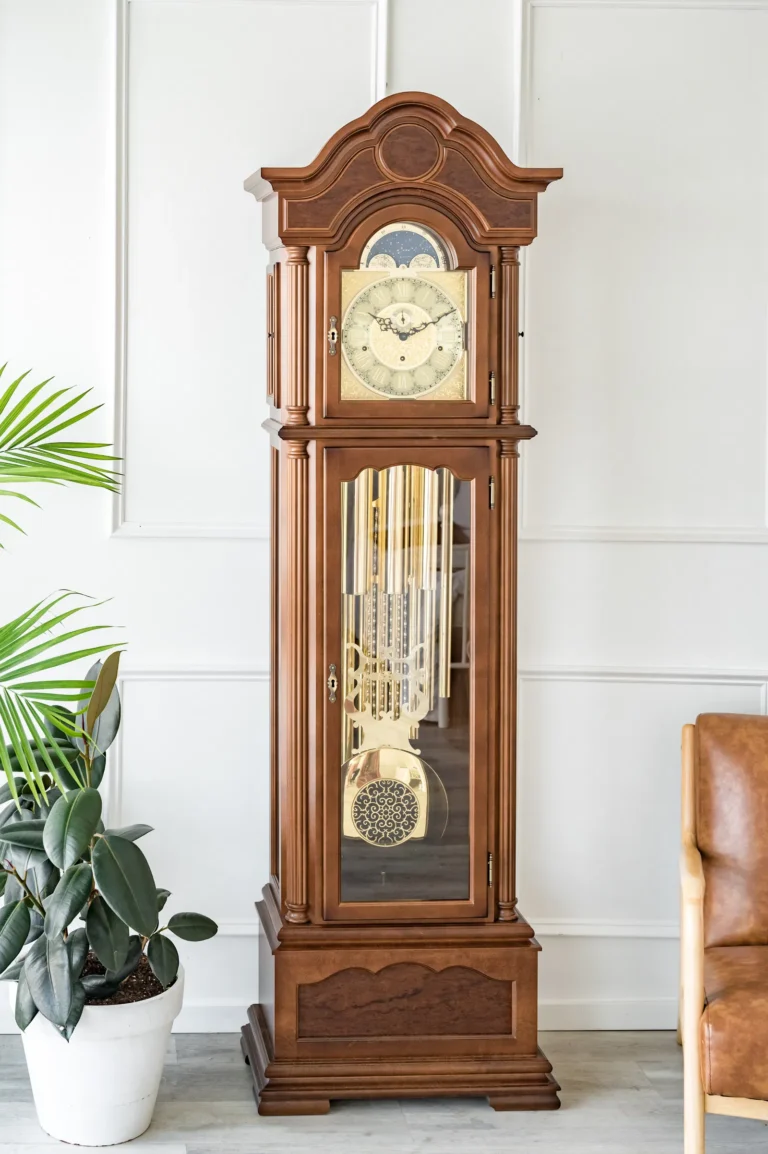What Is a Grandfather Clock?
A grandfather clock isn’t just any timepiece—it’s a towering symbol of tradition, craftsmanship, and elegance. These tall, freestanding clocks have been a staple in homes for generations, known for their gentle ticking and deep, melodic chimes.
The Origins of the Name
You might be wondering, Why “grandfather” clock? The name actually comes from the song “My Grandfather’s Clock” written in 1876 by Henry Clay Work. It told the story of a longcase clock that stood in the narrator’s grandfather’s home, and the term stuck ever since.
How It Differs From Other Clocks
Grandfather clocks differ from wall or mantel clocks by their impressive height, often towering over six feet. It has a long body housing weights and a swinging pendulum, and it often features melodious chimes, like the Westminster chime you might recognize from old films or church bells.
A Brief History of Grandfather Clocks
From the 17th Century to Modern Times
The story begins in the late 1600s when longcase clocks were first created. Clockmakers extended the case to house the long pendulum, resulting in the iconic silhouette we know today.
The Influence of William Clement
In 1670, English clockmaker William Clement improved the anchor escapement mechanism, allowing for longer pendulums. This advance led to more accurate timekeeping—and ultimately, the birth of the grandfather clock as we know it.
Anatomy of a Grandfather Clock
Let’s take a quick peek under the hood (so to speak).
The Clock Face and Hands
This is the business end of the clock. You’ve got the dial (often ornately decorated), the hour and minute hands, and sometimes a moon phase dial or calendar.
Weights and Pendulums
Inside, you’ll usually find three hanging weights—each serving a purpose: one powers the timekeeping, another controls the chimes, and the third handles the hourly strikes. As the clock runs, these weights gradually lower. The pendulum keeps it all in rhythm.
Chimes and Melodies
Many grandfather clocks chime every 15 minutes and strike on the hour. Some even let you choose between melodies like Westminster, Whittington, or St. Michael.
Styles of Grandfather Clocks
Whether you love classic or modern, there’s a grandfather clock style to suit your taste.
Traditional Designs
Think carved wood, brass details, and ornate dials. These are the clocks you’d find in historic estates or your grandparents’ hallway.
Contemporary Takes
Today’s designs can be minimalistic, with sleek metal or glass elements. They continue to add character, but with a sleek, contemporary edge.
Colonial and Victorian Styles
For history buffs or antique lovers, clocks from these eras are pure gold. They often feature rich mahogany wood, beveled glass, and intricate craftsmanship.
Why People Still Love Grandfather Clocks
Nostalgia and Heritage
They remind us of simpler times—of family gatherings, quiet nights, and the steady tick-tock echoing in the background.
Aesthetic and Interior Design
Let’s face it: nothing adds character to a room quite like a grandfather clock. It’s a striking and elegant decor piece that blends practicality with style.
Tips for Buying a Grandfather Clock
It’s not like buying a toaster. Here’s what to keep in mind.
New vs. Antique
Antiques have soul, but they also come with maintenance needs. New clocks often offer more reliability and modern features like volume control or automatic night shut-off.
Mechanical vs. Quartz
Mechanical clocks are weight- or spring-driven and require winding. Quartz models use batteries and need less upkeep, but they lack the classic ticking sound and feel.
Trusted Brands to Consider
Brands such as Howard Miller, Hentschel, and Ridgeway are well-known for their craftsmanship and reputation in the world of clocks.Brands such as Howard Miller, Hentschel, and Ridgeway are well-known for their craftsmanship and reputation in the world of clocks. They’ve been crafting quality timepieces for generations.
How to Maintain Your Grandfather Clock
A grandfather clock is a long-term companion, so a little care goes a long way.
Winding and Setting
Wind it weekly, using the crank provided. Set the time by moving the minute hand clockwise—never the hour hand!
Regular Cleaning
Dust the exterior regularly. As for the interior, don’t try to clean the mechanism unless you’re trained. Leave it to the pros.
Professional Servicing
Every 3–5 years, it’s smart to get a professional tune-up. This keeps everything running smoothly and extends the clock’s lifespan.
Can You Have a Grandfather Clock in a Modern Home?
Absolutely! Here’s How
Mixing old and new can create a stunning aesthetic. A sleek grandfather clock in a minimalist room adds warmth and character. Or go bold and make it a centerpiece in your living room. Trust us—it works.
Conclusion
A grandfather clock is more than just a device that tells time—it’s a legacy, a work of art, and a timeless treasure. Whether you’re restoring an antique or buying a brand-new piece, bringing one into your home is like inviting in a bit of history, rhythm, and heart.
So next time you hear that iconic chime echo through a room, take a moment to appreciate the craftsmanship, the story, and the soul that comes with every tick and tock.
FAQs
1. How tall is a typical grandfather clock?
Most grandfather clocks range from 6 to 8 feet tall, though some can be even taller or shorter depending on design.
2. Are grandfather clocks expensive?
Prices vary widely. A basic model might cost around $500, while handcrafted or antique clocks can reach $10,000 or more.
3. Is it safe to relocate a grandfather clock on your own?
It’s best to hire professionals. These clocks are delicate, and improper handling can damage the weights or pendulum.
4. Do grandfather clocks still need winding?
Mechanical models do—typically once a week. Quartz models run on batteries and don’t require winding.
5. How does a grandmother clock differ from a grandfather clock?
Size! Grandmother clocks are shorter—usually under 6 feet tall—but otherwise similar in design and function.

